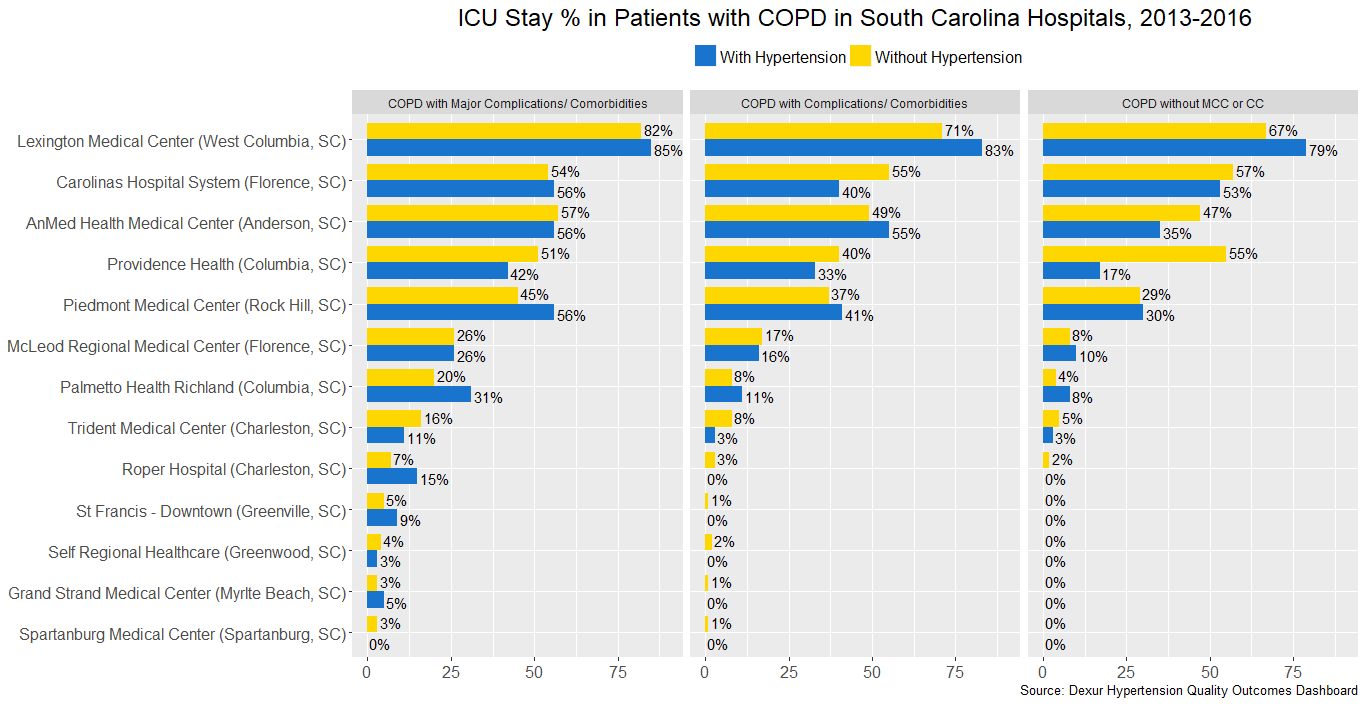At Lexington Medical Center, COPD Patients Have Highest Rate of ICU Stays in South Carolina, Both With and Without Hypertension
In Chronic Obstructive Pulmonary Disease (COPD)
Get Dexur’s Personalized Hospital Specific Presentation on Quality, Safety, Compliance & Education
By: James Pitt Jul. 09, 2018
A Dexur analysis examined hospital-level data on intensive care unit stays among Medicare-eligible inpatients with COPD in South Carolina. Dexur has previously reported on how COPD complications raise hypertension readmission rates in South Carolina.
ICU stay rates were higher among COPD patients with major complications. This was also true of readmission rates. However, whether a COPD patient had an ICU stay depended primarily on which hospital they were at, not on their COPD complications or hypertension status. On average, hypertension status was associated with higher ICU stay rates in patients with major complications, and lower ICU stay rates in other patients; the effect was too small to make a conclusive statement.

This may reflect differences in hospital policy, rather than patient populations with different needs. Lexington Medical Center (West Columbia, SC) admitted a higher percentage of COPD patients to intensive care than any other hospital in the sample. This is likely because of Lexington's highly ranked pulmonary rehab unit, a special facility for patients with COPD.
Other hospitals in adjacent Columbia, SC admitted much lower percentages of patients to intensive care. Lexington Medical Center reported 778 COPD discharges to CMS from 2013-2016. Providence Health reported about half as many (398), and Palmetto Health about two-thirds as many (570). Both of these hospitals had much lower ICU stay percentages among COPD patients than Lexington Medical Center.
However, the number of COPD discharges at a hospital did not correlate with the rate of ICU stays among COPD patients at that hospital. Spartanburg Medical Center (Spartanburg, SC) had 1,505 CMS inpatient discharges with COPD from 2013 to 2016, including 204 with hypertension. Less than 1% had ICU stays.
ICU stays are intense and expensive. For conditions including COPD and hyponatremia, Dexur has found that ICU stay rates vary widely across hospitals.
DEXUR PRO MEMBERS GET ACCESS TO:
- Total DRG Discharges
- Total Hypertension Discharges at DRG
- % of Hypertension Discharges at DRG
- Percentage of discharges at DRG with ICU Stay
- Percentage of discharges at DRG with ICU Stay Without Hypertension
- Percentage of discharges at DRG with ICU Stay With Hypertension
- Difference in ICU Stay with and without Hypertension
- State Difference in ICU Stay % with & without Hypertension
- National Difference in ICU Stay % with & without Hypertension
For DRG 190, DRG 191, and DRG 192, from 2013-2016, at the following hospitals:
- AnMed Health Medical Center (Anderson, SC)
- Carolinas Hospital System (Florence, SC)
- Grand Strand Medical Center (Myrlte Beach, SC)
- Lexington Medical Center (West Columbia, SC)
- McLeod Regional Medical Center (Florence, SC)
- Palmetto Health Richland (Columbia, SC)
- Piedmont Medical Center (Rock Hill, SC)
- Providence Health (Columbia, SC)
- Roper Hospital (Charleston, SC)
- Self Regional Healthcare (Greenwood, SC)
- Spartanburg Medical Center (Spartanburg, SC)
- St Francis - Downtown (Greenville, SC)
- Trident Medical Center (Charleston, SC)
ABOUT THE AUTHOR
